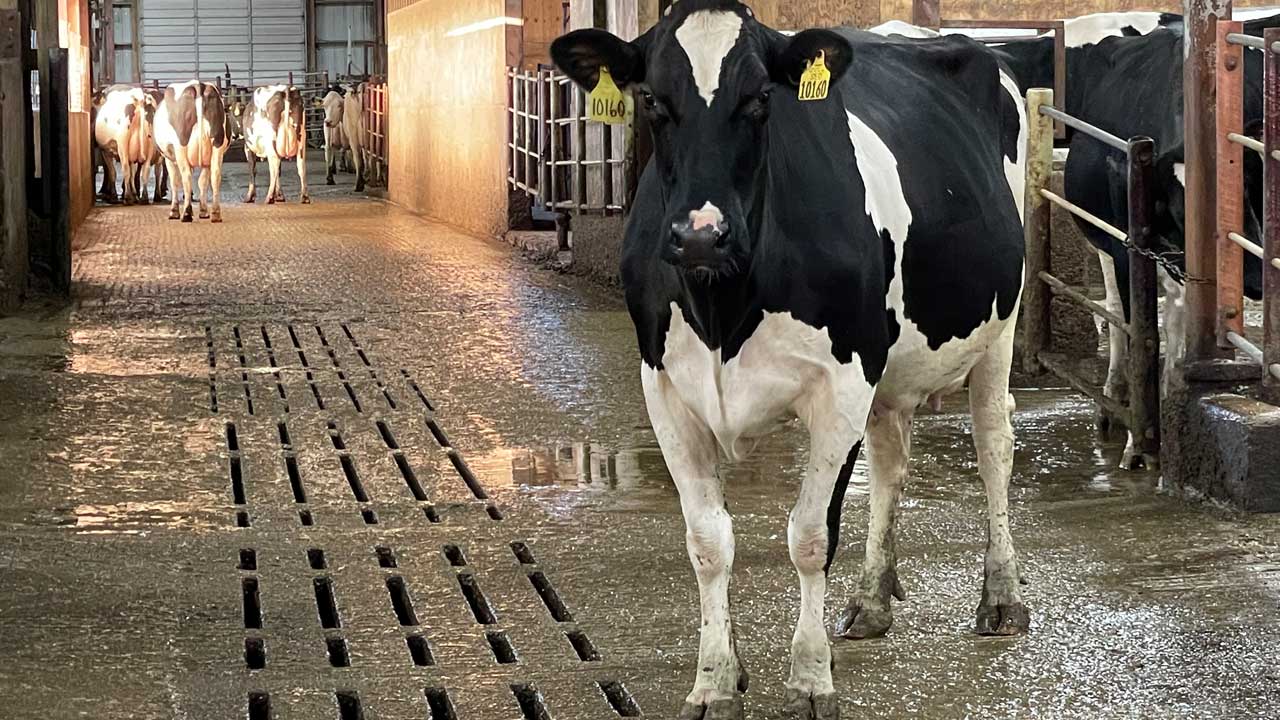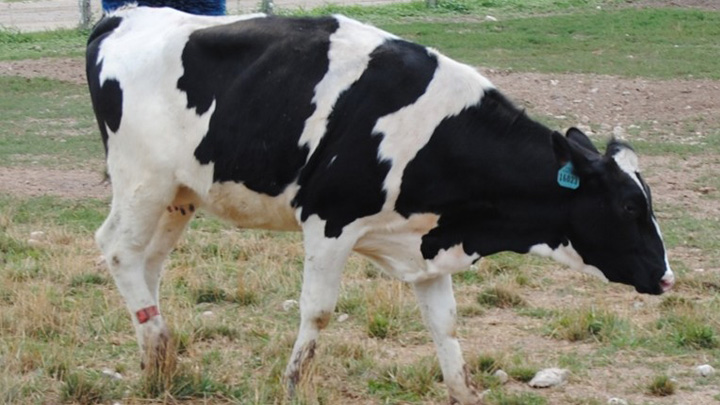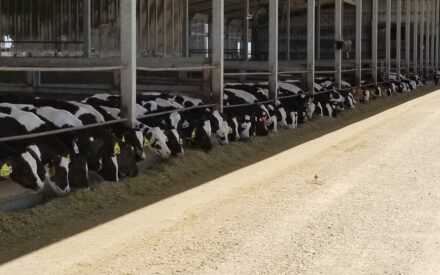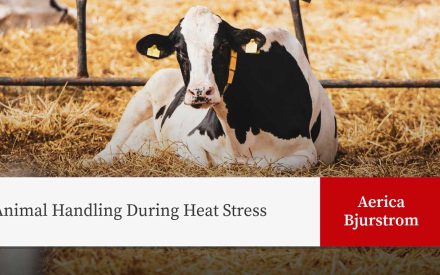Introduction
Lameness issues impact every dairy herd in one form or another. Not only does lameness affect a cow’s health and well-being, but it’s also costly to the farm’s bottom line. Lameness cases in the dairy herd impact reproduction, milk production, herd health, and longevity. A 2018 study (Dolecheck and Bewley) summarized several studies estimating the cost of lameness and found that lameness can cost between $76 and $533 per case. In a study in the Journal of Dairy Science, Dr. Philip Rasmussen of the University of Copenhagen, Denmark, explored the impact of disease on dairy cattle. Rasmussen found that lameness costs the dairy industry $6 billion annually globally.
Lameness in Dairy Cattle
Lameness in dairy cattle is a significant welfare concern and one of the leading causes of reduced productivity and profitability on dairy farms. The leading cause of lameness is claw lesions, which are either non-infectious (white line disease, sole ulcer, sole hemorrhage, interdigital hyperplasia) or infectious, including digital dermatitis (DD), interdigital dermatitis, heel erosion, and interdigital phlegmon (foot rot). Less common causes of lameness can be injuries, infections, nutritional imbalances, or management practices.

(Photo: Aerica Bjurstrom)
Prevalence Impact
The global incidence of lameness varies but can affect between 13% and 50% of dairy cows at some point in their lives. Several factors contribute to lameness in dairy cattle, including the type of housing, the cow’s age, and other health issues. Additionally, a cow’s breed and phenotype can impact its prevalence of lameness.
Lameness is a significant health concern for dairy producers, and it can contribute to a cow’s early exit from the herd. Cow welfare is also impacted by lameness. Lameness contributes to animal pain and their ability to express normal social behavior, eat, stand, and rest. Compromised welfare reduces production and fertility.
Lameness affects cattle of different age groups. For example, fractures are most common in calves, while hoof overgrowth is most common in yearlings. Cows most often suffer from infectious diseases and trauma to the hoof.
Risk Factors
The type of housing system used on a dairy farm is critical in developing and preventing lameness. Housing affects how much cows can move, how clean and dry their environment remains, and the condition of walking surfaces—all of which directly impact hoof health. Different systems present unique challenges and risks when it comes to managing lameness, as outlined below:
Housing Systems
Tie-Stalls
Confining cows to small stalls for prolonged periods can increase lameness risk due to limited movement and poor hoof care.
Loose Housing
Cows in freestall barns with non-slip flooring have better mobility but are still vulnerable to lameness, especially if bedding is insufficient or floor surfaces are rough (Figure 1).
Herd Management Practices
Beyond housing, several additional management and environmental factors contribute to the risk of lameness in dairy cattle. Routine practices such as hoof trimming and milking schedules, along with changing weather and pen conditions, can either support hoof health or increase vulnerability to lameness. Understanding and addressing these risks is essential for maintaining a healthy, productive herd, as highlighted below:
Hoof Trimming
Regular, professional hoof trimming (every 6-8 weeks) is vital for preventing lameness, but improper trimming can cause or worsen lameness.
Milking Routine
High milking frequencies and extended standing times in the parlor can exacerbate hoof problems, especially in cows that are already lame.
Climate and Environmental Conditions
Wet and Muddy Conditions
Wet and muddy pens or pastures increase the risk of infections like digital dermatitis.
Temperature Extremes
High temperatures can cause increased standing times and hoof stress, while cold, wet conditions can encourage infections.
Signs of Lameness
Early lameness identification is crucial to minimizing its impact on cow health and farm performance. Recognizing the subtle and not-so-subtle signs of lameness allows for prompt treatment and can prevent further complications. The following indicators are common warning signs that a cow may be experiencing lameness and should be closely monitored:
Change in Gait
Cows may walk with a limp, favoring one or more legs (Figure 2).
Reluctance to Stand or Walk
A cow may spend more time lying down and hesitating to move.
Favoring One Limb
Limping or shifting weight away from one leg.
Reduced Milk Yield
Lame cows are often less productive, partly due to discomfort.

(Photo: Aerica Bjurstrom)
Management and Prevention Strategies
Effective lameness prevention and control on dairy farms relies on a combination of proactive management practices that support hoof health, minimize risk factors, and ensure timely intervention. The following strategies are essential components of a comprehensive lameness prevention program:
Hoof Care
Regular hoof trimming (every 6-8 weeks) helps to maintain hoof health. Early detection and treatment of infections like digital dermatitis or hoof rot are essential.
Housing Improvements
Providing soft, non-slip flooring in cow housing areas and walkways helps reduce the risk of injury. Ensure that bedding is clean, dry, and plentiful to relieve pressure on the hooves and prevent infections.
Nutritional Management
Ensuring cows receive a balanced diet with adequate levels of vitamins and minerals, especially zinc, copper, and biotin, can promote healthy hooves.
Herd Management
Lame cows that do not respond to treatment or have chronic hoof problems should be marketed early to avoid further economic losses.
Footbaths
Regular use of footbaths (containing copper sulfate or formaldehyde) can help prevent infections like digital dermatitis.
Monitoring and Early Detection
Invest in technologies for monitoring cow behavior (e.g., activity trackers) to detect lameness early. Train farm staff to recognize early signs of lameness and take immediate action.
Research and Innovations
Ongoing research and innovation are vital in advancing the prevention and management of lameness in dairy cattle. As producers seek long-term, sustainable solutions, emerging technologies and breeding strategies offer promising tools to reduce lameness risk and improve overall herd health. The following developments highlight key areas of focus in lameness-related research:
Genetic Selection
Improving hoof health through genetics is a promising long-term strategy for reducing lameness in dairy cattle. Current research is focused on identifying and selecting traits such as stronger hoof structure, better leg conformation, and overall mobility. These traits are being integrated into genetic evaluation programs to help farmers breed more lameness-resistant cows. By selecting sires and dams with favorable locomotion and hoof health scores, producers can gradually build herds with improved resilience to hoof-related issues, ultimately reducing reliance on intensive management practices and treatments.
Automated Lameness Detection
Advances in technology are making it possible to identify lameness earlier and more accurately through automated systems. Tools like camera-based gait analysis, pressure-sensitive walkways, and wearable activity monitors can track cow movement and behavior changes that may indicate discomfort or lameness. These technologies offer continuous, objective monitoring and can alert farm staff to subtle changes before they become more serious. By catching issues early, farmers can intervene promptly, improving treatment outcomes and minimizing the impact on milk production and animal welfare.
Alternative Bedding Materials
Bedding plays a critical role in hoof health and overall comfort for dairy cows. Researchers are evaluating alternative bedding materials—such as rubber mats, deep-bedded sand, and composted manure solids—for their ability to reduce pressure on the hooves, improve traction, and keep cows dry and clean. Each material presents different benefits and challenges, depending on the farm’s management system and environment. For example, sand has excellent cushioning and drainage properties, while rubber mats provide a more uniform, slip-resistant surface. Choosing the right bedding material can significantly reduce lameness incidence and improve lying time, both of which support overall herd health and productivity
Summary
Lameness in dairy cattle remains a significant concern for animal welfare and farm economics. Preventive measures—such as consistent hoof care, appropriate housing, and balanced nutrition—are the most effective ways to reduce its occurrence. Early detection and prompt treatment are equally important to minimize the negative impacts on cow health and productivity. By recognizing risk factors and implementing targeted management strategies, dairy farmers can significantly lower lameness rates, support cow well-being, and improve their operations’ overall efficiency and success.
Authors

Aerica Bjurstrom
Regional Dairy Educator – Aerica’s work focuses on herd health and animal welfare. She also has a strong background in meat quality and has done programming in market cow carcass quality.
References
- Archer, S. C., Green, M. J., & Huxley, J. N. (2010). Association between milk yield and serial locomotion score assessments in UK dairy cows. Journal of Dairy Science, 93(10), 4045–4053. https://pubmed.ncbi.nlm.nih.gov/20723678/
- Cook, N. B., & Nordlund, K. V. (2009). The influence of the environment on dairy cow behavior, claw health and herd lameness dynamics. Veterinary Journal, 179(3), 360–369. https://doi.org/10.1016/j.tvjl.2007.09.016
- Espejo, L. A., Endres, M. I., & Salfer, J. A. (2006). Prevalence of lameness in high-producing Holstein cows housed in freestall barns in Minnesota. Journal of Dairy Science, 89(8), 3052-3058. https://doi.org/10.3168/jds.S0022-0302(06)72579-6
- Rasmussen, P., Sørensen, J. T., & Bennedsgaard, T. W. (2024). Global losses due to dairy cattle diseases: A comorbidity-adjusted economic analysis. Journal of Dairy Science, 107(9), 7850–7865. https://www.sciencedirect.com/science/article/pii/S002203022400821X
- Whay, H. R., Waterman, A. E., & Webster, A. J. F. (1997). Associations between locomotion, claw lesions, and nociceptive threshold in dairy heifers during the peripartum period. Veterinary Journal, 154(2), 155–161. https://pubmed.ncbi.nlm.nih.gov/9308402/
The University of Wisconsin–Madison Division of Extension provides equal opportunities in employment and programming in compliance with state and federal law.


 Lameness Starts in the Heifer Pen
Lameness Starts in the Heifer Pen Animal Handling During Heat Stress
Animal Handling During Heat Stress Handling down cows
Handling down cows Are my dairy cattle fit for transport?
Are my dairy cattle fit for transport?


